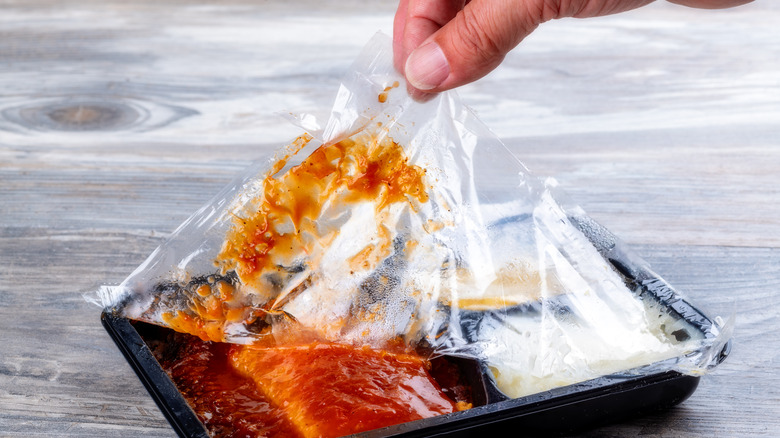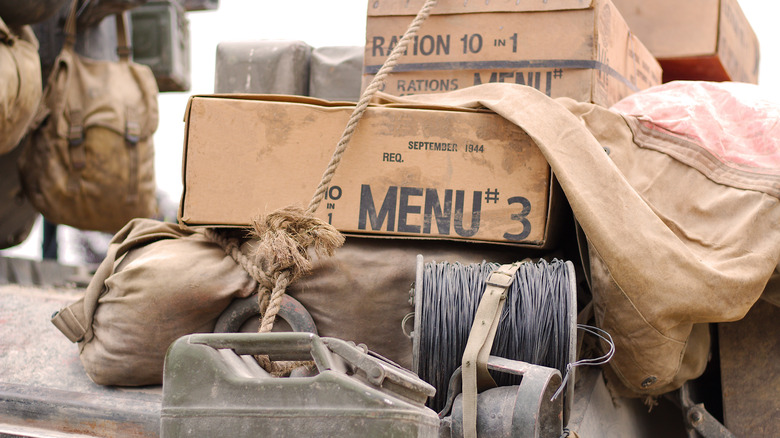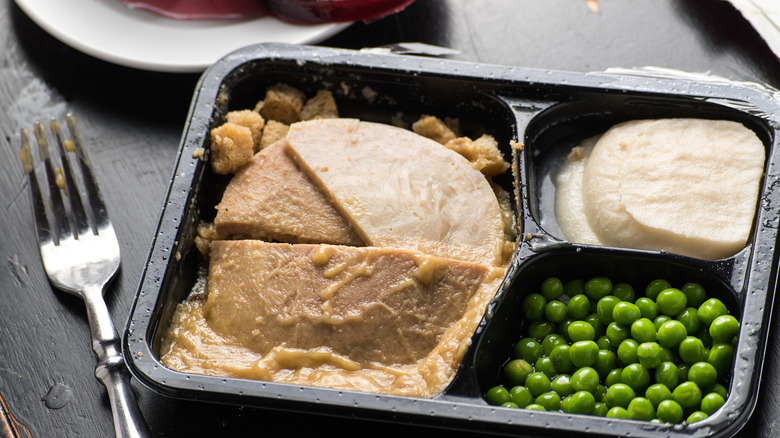The Contentious History Of The TV Dinner
With its iconic microwavable plate neatly divided into separate compartments for soup, meat, vegetable, and dessert, the TV dinner has a long-storied and mythic place in American food history and culture. In the early 1950s, television sets began to oust the radio and take over American households as the prime form of entertainment. By 1959, according to Britannica, nearly 86% of American households contained a television set.
Perhaps the best-known company for TV dinners, Swanson, had the foresight to take advantage of this phenomenon and began to market TV dinners to American consumers by advertising women serving these newly packaged meals to their families (per Smithsonian Magazine). It was an easy sell: A pre-cooked, pre-portioned frozen meal that simply needed to be popped into the microwave was an easy solution for dinner, especially for women at the time often tasked with the full responsibilities of keeping a home.
But the invention of the frozen dinner didn't start with Swanson; its history is far more complex.
Fish's influence on frozen meals
Naturalist, entrepreneur, and founder of the frozen food industry Clarence Birdseye spent time living amongst Canada's Inuit people (via History). Per Up Here, Birdseye was fur-trading in the chilly Labrador region when he was taught to flash-freeze fish. Birdseye took his experiences and learnings from the Indigenous people and used their food preservation techniques to develop a way to commercialize this fish-freezing process. His double-belt flash-freezing technology was superior to other commercial freezing methods available at that time. Birdseye's invention helped foods keep their original texture, freshness, and flavor. Encouraged, Birdseye patented the method for freezing vegetables.
Despite Birdseye's ambitions within the frozen food industry, the consumer market was just not hot enough to accept frozen meals. Many households at the time didn't even have freezers. But by 1939, World War II had taken over the country's consciousness, and the need for convenient food preparation had changed.
The beginnings of frozen dinners
Long before frozen meals became part of 'The New Normal,' the first product that resembled a TV dinner appeared in 1945; it was called a "Strato-Plate," and per the Library of Congress, it was a three-part meal made up of frozen vegetables, meat, and potatoes. However, instead of being consumed in front of a television set, these meals were made specifically for military and civilian airplane passengers.
Though Maxson Food Systems put frozen dinners onto divided plates, after the founder died, Strato-Plates failed to launch from planes into the consumer retail market. The idea of the frozen meal was not forgotten, however, and competitors began to make their own versions: Jack Fisher made FridgiDinners and sold them to bars and taverns, and the Bernstein brothers made three-compartment frozen dinners with aluminum trays. They were the first to successfully sell to consumers, and in 1952 formed Quaker State Food Corporation, selling 2.5 million frozen meals by 1954 (via Today I Found Out).
Frozen turkeys and Gerry Thomas
The following year, in 1953, Swanson found themselves saddled with a poultry problem. Unsold turkeys from the previous Thanksgiving, to the tune of 520,000 pounds, according to Smithsonian Magazine, were stored in refrigerated railway cars. The meat was only kept cold during transit, so executives were desperate to come up with a solution. The very first TV dinner came to the rescue, but the idea was originally credited to one person.
If one were playing "Jeopardy" and the answer was the inventor of the TV dinner, the question "Who is Gerry Thomas?" would likely be accepted as true. Legend has it that Gerry Thomas was a salesperson for Swanson when he saw aluminum trays in a warehouse and was inspired to sketch the now-famous three-compartment tray (per History). However, the namesakes for the Swanson company themselves, Gilbert and Clarke Swanson, claimed credit and took inspiration for their famous TV dinners from the airline food trays.
From TV channels to streaming shows
Even though the modern image of America no longer resembles a family eating on trays in front of an old television set, the concept of a TV dinner hasn't gone away. Convenient meals have simply evolved into a different form. According to The Columbus Dispatch, a 2016 Nielsen report notes that the average adult in America spends over five hours in front of a television. Though mindful eating has gained popularity in America, Americans still have a habit of chowing down on food while watching their favorite sitcom series (via Harvard T.H. Chan School of Public Health).
Despite evidence showing why eating in front of a television is bad for you, there is also research investigating why we do it. A study published in Trends in Cognitive Sciences described that the dopamine fix our brains get from eating food is doubled when we watch television. Like it or not, it seems as if the TV dinner is here to stay; choose your frozen dinner brands carefully.




